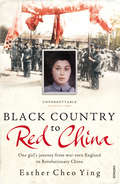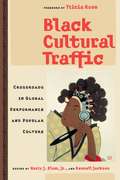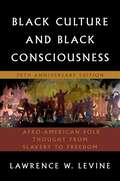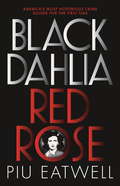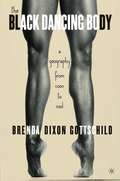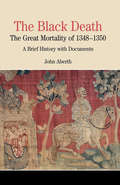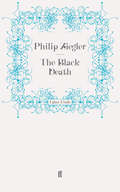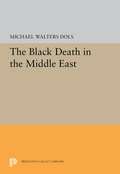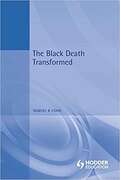- Table View
- List View
Black Country to Red China: One girl's story from war-torn England to Revolutionary China
by Esther Cheo YingBorn in pre-Revolutionary China and brought up in the Midlands, Esther Cheo Ying returned to China in 1949 after a traumatic childhood, convinced that there she would find the happiness and sense of belonging she longed for. Caught up in the turmoil of civil war and sympathetic to the Communist Revolution, she joined the Red Army and then stayed on to work in the new People's Republic. But despite her determination to make a new life in China could she truly be happy in a country which encouraged constant self-criticism and viewed her as a 'false foreign devil'? Black Country to Red China is an extraordinary account of life before the Cultural Revolution, but it is also a fascinating insight into one woman's struggle to come to terms with your own identity.
Black Critics and Kings: The Hermeneutics of Power in Yoruba Society
by Andrew ApterHow can we account for the power of ritual? This is the guiding question of Black Critics and Kings, which examines how Yoruba forms of ritual and knowledge shape politics, history, and resistance against the state. Focusing on "deep" knowledge in Yoruba cosmology as an interpretive space for configuring difference, Andrew Apter analyzes ritual empowerment as an essentially critical practice, one that revises authoritative discourses of space, time, gender, and sovereignty to promote political—-and even violent—-change. Documenting the development of a Yoruba kingdom from its nineteenth-century genesis to Nigeria's 1983 elections and subsequent military coup, Apter identifies the central role of ritual in reconfiguring power relations both internally and in relation to wider political arenas. What emerges is an ethnography of an interpretive vision that has broadened the horizons of local knowledge to embrace Christianity, colonialism, class formation, and the contemporary Nigerian state. In this capacity, Yoruba òrìsà worship remains a critical site of response to hegemonic interventions. With sustained theoretical argument and empirical rigor, Apter answers critical anthropologists who interrogate the possibility of ethnography. He reveals how an indigenous hermeneutics of power is put into ritual practice—-with multiple voices, self-reflexive awareness, and concrete political results. Black Critics and Kings eloquently illustrates the ethnographic value of listening to the voice of the other, with implications extending beyond anthropology to engage leading debates in black critical theory.
Black Cultural Life in South Africa: Reception, Apartheid, and Ethics (African Perspectives)
by Lily SaintUnder apartheid, black South Africans experienced severe material and social disadvantages occasioned by the government’s policies, and they had limited time for entertainment. Still, they closely engaged with an array of textual and visual cultures in ways that shaped their responses to this period of ethical crisis. Marshaling forms of historical evidence that include passbooks, memoirs, American “B” movies, literary and genre fiction, magazines, and photocomics, Black Cultural Life in South Africa considers the importance of popular genres and audiences in the relationship between ethical consciousness and aesthetic engagement. This study provocatively posits that states of oppression, including colonial and postcolonial rule, can elicit ethical responses to imaginative identification through encounters with popular culture, and it asks whether and how they carry over into ethical action. Its consideration of how globalized popular culture “travels” not just in material form, but also through the circuits of the imaginary, opens a new window for exploring the ethical and liberatory stakes of popular culture. Each chapter focuses on a separate genre, yet the overall interdisciplinary approach to the study of genre and argument for an expansion of ethical theory that draws on texts beyond the Western canon speak to growing concerns about studying genres and disciplines in isolation. Freed from oversimplified treatments of popular forms—common to cultural studies and ethical theory alike—this book demonstrates that people can do things with mass culture that reinvigorate ethical life. Lily Saint’s new volume will interest Africanists across the humanities and the social sciences, and scholars of Anglophone literary, globalization, and cultural studies; race; ethical theories and philosophies; film studies; book history and material cultures; and the burgeoning field of comics and graphic novels.
Black Cultural Traffic: Crossroads in Global Performance and Popular Culture
by Harry J. Elam Kennell Jackson"A shrewdly designed, generously expansive, timely contribution to our understanding of how 'black' expression continues to define and defy the contours of global (post)modernity. The essays argue persuasively for a transnational ethos binding disparate African and diasporic enactments, and together provide a robust conversation about the nature, history, future, and even possibility of 'blackness' as a distinctive mode of cultural practice." --Kimberly Benston, author of Performing Blackness "Black Cultural Traffic is nothing less than our generation's manifesto on black performance and popular culture. With a distinguished roster of contributors and topics ranging across academic disciplines and the arts (including commentary on film, music, literature, theater, television, and visual cultures), this volume is not only required reading for scholars serious about the various dimensions of black performance, it is also a timely and necessary teaching tool. It captures the excitement and intellectual innovation of a field that has come of age. Kudos!" --Dwight A. McBride, author of Why I Hate Abercrombie & Fitch "The explosion of interest in black popular culture studies in the past fifteen years has left a significant need for a reader that reflects this new scholarly energy. Black Cultural Traffic answers that need." --Mark Anthony Neal, author of Songs in the Key of Black Life "A revolutionary anthology that will be widely read and taught. It crisscrosses continents and cultures and examines confluences and influences of black popular culture -- music, dance, theatre, television, fashion and film. It also adds a new dimension to current discussions of racial, ethnic, and national identity." --Horace Porter, author of The Making of a Black Scholar
Black Culture and Black Consciousness: Afro-American Folk Thought from Slavery to Freedom
by the late Lawrence W. LevineWhen Black Culture and Black Consciousness first appeared thirty years ago, it marked a revolution in our understanding of African American history. Contrary to prevailing ideas at the time, which held that African culture disappeared quickly under slavery and that black Americans had little group pride, history, or cohesiveness, Levine uncovered a cultural treasure trove, illuminating a rich and complex African American oral tradition, including songs, proverbs, jokes, folktales, and long narrative poems called toasts--work that dated from before and after emancipation. The fact that these ideas and sources seem so commonplace now is in large part due this book and the scholarship that followed in its wake. A landmark work that was part of the "cultural turn" in American history, Black Culture and Black Consciousness profoundly influenced an entire generation of historians and continues to be read and taught. For this anniversary reissue, Levine wrote a new preface reflecting on the writing of the book and its place within intellectual trends in African American and American cultural history.
Black Culture and Black Consciousness: Afro-American Folk Thought from Slavery to Freedom
by the late Lawrence W. LevineWhen Black Culture and Black Consciousness first appeared thirty years ago, it marked a revolution in our understanding of African American history. Contrary to prevailing ideas at the time, which held that African culture disappeared quickly under slavery and that black Americans had little group pride, history, or cohesiveness, Levine uncovered a cultural treasure trove, illuminating a rich and complex African American oral tradition, including songs, proverbs, jokes, folktales, and long narrative poems called toasts--work that dated from before and after emancipation. The fact that these ideas and sources seem so commonplace now is in large part due this book and the scholarship that followed in its wake. A landmark work that was part of the "cultural turn" in American history, Black Culture and Black Consciousness profoundly influenced an entire generation of historians and continues to be read and taught. For this anniversary reissue, Levine wrote a new preface reflecting on the writing of the book and its place within intellectual trends in African American and American cultural history.
Black Culture, Inc.: How Ethnic Community Support Pays for Corporate America (Culture and Economic Life)
by Patricia A. BanksA surprising and fascinating look at how Black culture has been leveraged by corporate America. Open the brochure for the Alvin Ailey American Dance Theater, and you'll see logos for corporations like American Express. Visit the website for the Apollo Theater, and you'll notice acknowledgments to corporations like Coca Cola and Citibank. The Martin Luther King, Jr. Memorial and the National Museum of African American History and Culture, owe their very existence to large corporate donations from companies like General Motors. And while we can easily make sense of the need for such funding to keep cultural spaces afloat, less obvious are the reasons that corporations give to them. In Black Culture, Inc., Patricia A. Banks interrogates the notion that such giving is completely altruistic, and argues for a deeper understanding of the hidden transactions being conducted that render corporate America dependent on Black culture. Drawing on a range of sources, such as public relations and advertising texts on corporate cultural patronage and observations at sponsored cultural events, Banks argues that Black cultural patronage profits firms by signaling that they value diversity, equity, and inclusion. By functioning in this manner, support of Black cultural initiatives affords these companies something called "diversity capital," an increasingly valuable commodity in today's business landscape. While this does not necessarily detract from the social good that cultural patronage does, it reveals its secret cost: ethnic community support may serve to obscure an otherwise poor track record with social justice. Banks deftly weaves innovative theory with detailed observations and a discerning critical gaze at the various agendas infiltrating memorials, museums, and music festivals meant to celebrate Black culture. At a time when accusations of discriminatory practices are met with immediate legal and social condemnation, the insights offered here are urgent and necessary.
The Black Culture Industry
by Ellis CashmoreCashmore's controversial study argues that black culture has been converted into a commodity, usually in the interests of white owned corporations. Using detailed studies of the marketing of Motown, Michael Jackson and the Artist Formerly Known as Prince, Cashmore suggests that inflating the significance of this commodified 'black culture' may actually be counter-productive in the struggle for racial justice.
The Black Culture Industry
by Ellis CashmoreCashmore's controversial study argues that black culture has been converted into a commodity, usually in the interests of white owned corporations. Using detailed studies of the marketing of Motown, Michael Jackson and the Artist Formerly Known as Prince, Cashmore suggests that inflating the significance of this commodified 'black culture' may actually be counter-productive in the struggle for racial justice.
Black cumin (Food Bioactive Ingredients)
by Mohamed Fawzy RamadanRecent developments in the field of nutrition have led to increased interest in herbs and medicinal plants as phytochemical-rich sources for functional food, nutraceuticals, and drugs. As research sheds light on the therapeutic potential of various bioactive phytochemicals, the demand for plant extracts and oils has increased. Black cumin or black seeds (Nigella sativa) have particularly widespread nutritional and medicinal applications. In traditional medicine, black seeds are used to manage fatigue and chronic headache. Black seed oil is used as an antiseptic and analgesic remedy and for treatment of joint's pain and stiffness and can be mixed with sesame oil to treat dermatosis, abdominal disorders, cough, headache, fever, liver ailments, jaundice, sore eyes, and hemorrhoids. Thymoquinone, the main constituent in black seed volatile oil, has been shown to suppress carcinogenesis. Black cumin (Nigella sativa) seeds: Chemistry, Technology, Functionality, and Applications presents in detail the chemical composition, therapeutic properties, and functionality of high-value oils, phytochemicals, nutrients, and volatiles of the Nigella sativa seed. Organized by formulation (seeds, fixed oil, essential oil, and extracts), chapters break this seed down into its chemical constituents and explore their role in the development of pharmaceuticals, nutraceuticals, novel food, natural drugs, and feed. Following numerous reports on the health-promoting activities of Nigella sativa, this is the first comprehensive presentation of the functional, nutritional, and pharmacological traits of Nigella sativa seeds and seed oil constituents.
Black Dahlia, Red Rose: A 'Times Book of the Year'
by Piu Eatwell******* A TIMES 'BOOK OF THE YEAR' **********Shortlisted for the CWA Dagger for non-fiction***'A magnificent, meticulous and startling re-examination of a crime that haunts the world's imagination' Geoffrey Wansell, author of An Evil Love: The Life of Frederick West'Eatwell writes brilliantly . . . [she] has finally offered [Elizabeth] Short a type of belated justice. Her book reads like a thriller' Sunday Times'A compelling read, in both style and substance . . . A must-read for anyone with an interest in the Black Dahlia - or indeed any fan of the true-crime genre' Rod Reynolds, author of The Dark Inside'Compulsively readable, impeccably researched and heart-rending at times . . . Superb' Sarah Lotz, author of The Three and The White Road*************On 15th January 1947, the naked, dismembered body of a black-haired beauty, Elizabeth Short, was discovered lying next to a pavement in a Hollywood suburb. She was quickly nicknamed The Black Dahlia.The homicide inquiry that followed consumed Los Angeles for years and the authorities blew millions of dollars of resources on an investigation that threw up dozens of suspects. But it never was solved.Until now.In this ground-breaking book, Piu Eatwell reveals compelling forensic and eye witness evidence for the first time, which finally points to the identity of the murderer. The case was immortalised in James Ellroy's famous novel based on the case, in Kenneth Anger's Hollywood Babylon and Brian de Palma's movie The Black Dahlia.This is a dark tale of sex, manipulation, obsession, psychopathy and one of the biggest police cover ups in history.
The Black Dancing Body: A Geography From Coon to Cool
by B. GottschildWhat is the essence of black dance in America? To answer that question, Brenda Dixon Gottschild maps an unorthodox 'geography', the geography of the black dancing body, to show the central place black dance has in American culture. From the feet to the butt, to hair to skin/face, and beyond to the soul/spirit, Brenda Dixon Gottschild talks to some of the greatest choreographers of our day including Garth Fagan, Francesca Harper, Meredith Monk, Brenda Buffalino, Doug Elkins, Ralph Lemon, Fernando Bujones, Bill T. Jones, Trisha Brown, Jawole Zollar, Bebe Miller, Sean Curran and Shelly Washington to look at the evolution of black dance and it's importance to American culture. This is a groundbreaking piece of work by one of the foremost African-American dance critics of our day.
The Black Death: A New History of the Great Mortality in Europe, 1347-1500
by John AberthIn The Black Death: A New History of the Great Mortality in Europe, 1347-1500, leading scholar John Aberth provides the most authoritative, up-to-date treatment of the Black Death, giving not just a narrative account but also a thorough examination of the latest forensic, historical, and DNA evidence to date. Offering new information, research, and debates that have not been covered before in previous works, this unique text is poised to become the new standard resource on the Black Death.
The Black Death: An Intimate History
by John HatcherHow the people of a typical English village lived and died in the worst epidemic in history.The Black Death remains the greatest disaster to befall humanity, killing about half the population of the planet in the 14th century. John Hatcher recreates everyday medieval life in a parish in Suffolk, from which an exceptional number of documents survive. This enables us to view events through the eyes of its residents, revealing in unique detail what it was like to live and die in these terrifying times. With scrupulous attention to historical accuracy, John Hatcher describes what the parishioners experienced, what they knew and what they believed. His narrative is peopled with characters developed from the villagers named in the actual town records and a series of dramatic scenes portray how contemporaries must have experienced the momentous events.
The Black Death (Manchester Medieval Sources)
by Rosemary HorroxThis series provides texts central to medieval studies courses and focuses upon the diverse cultural, social and political conditions that affected the functioning of all levels of medieval society. Translations are accompanied by introductory and explanatory material and each volume includes a comprehensive guide to the sources' interpretation, including discussion of critical linguistic problems and an assessment of recent research on the topics covered. From 1348 to 1350 Europe was devastated by an epidemic that left between a third and one half of the population dead. This source book traces, through contemporary writings, the calamitous impact of the Black Death in Europe, with a particular emphasis on its spread across England from 1348 to 1349. Rosemary Horrox surveys contemporary attempts to explain the plague, which was universally regarded as an expression of divine vengeance for the sins of humankind. Moralists all had their particular targets for criticism. However, this emphasis on divine chastisement did not preclude attempts to explain the plague in medical or scientific terms. Also, there was a widespread belief that human agencies had been involved, and such scapegoats as foreigners, the poor and Jews were all accused of poisoning wells. The final section of the book charts the social and psychological impact of the plague, and its effect on the late-medieval economy.
The Black Death: From The Black Death To Ebola (Pocket Essentials: History Ser.)
by Sean MartinThe Black Death is the name most commonly given to the pandemic of bubonic plague that ravaged the medieval world in the late 1340s. From Central Asia the plague swept through Europe, leaving millions of dead in its wake. Between a quarter and a third of Europe's population died. In England the population fell from nearly six million to just over three million. The Black Death was the greatest demographic disaster in European history. Sean Martin looks at the origins of the disease and traces its terrible march through Europe from the Italian cities to the far-flung corners of Scandinavia. He describes contemporary responses to the plague and makes clear how helpless was the medicine of the day in the face of it. He examines the renewed persecution of the Jews, blamed by many Christians for the spread of the disease, and highlights the bizarre attempts by such groups as the Flagellants to ward off what they saw as the wrath of God. His book is a vivid and dramatic account of one of the great catastrophes of history.
The Black Death: The Great Mortality of 1348-1350: A Brief History with Documents (The Bedford Series in History and Culture)
by NA NAA fascinating account of the phenomenon known as the Black Death, this volume offers a wealth of documentary material focused on the initial outbreak of the plague that ravaged the world in the 14th century. A comprehensive introduction that provides important background on the origins and spread of the plague is followed by nearly 50 documents organized into topical sections that focus on the origin and spread of the illness; the responses of medical practitioners; the societal and economic impact; religious responses; the flagellant movement and attacks on Jews provoked by the plague; and the artistic response. Each chapter has an introduction that summarizes the issues explored in the documents; headnotes to the documents provide additional background material. The book contains documents from many countries - including Muslim and Byzantine sources - to give students a variety of perspectives on this devastating illness and its consequences. The volume also includes illustrations, a chronology of the Black Death, and questions to consider.
The Black Death (P. S. Ser.)
by Philip ZieglerBetween 1347 and 1350, the Black Death killed at least one third of Europe's population. Philip Ziegler's classic account traces the course of the virulent epidemic through Europe and its dramatic effect on the lives of those whom it afflicted. First published nearly forty years ago, it remains definitive.'The clarity and restraint on every page produce a most potent cumulative effect.' Michael Foot
The Black Death and the Transformation of the West
by David HerlihyLooking beyond the view of the plague as unmitigated catastrophe, Herlihy finds evidence for its role in the advent of new population controls, the establishment of universities, the spread of Christianity, the dissemination of vernacular cultures, and even the rise of nationalism. This book, which displays a distinguished scholar's masterly synthesis of diverse materials, reveals that the Black Death can be considered the cornerstone of the transformation of Europe.
The Black Death and the Transformation of the West
by David HerlihyLooking beyond the view of the plague as unmitigated catastrophe, Herlihy finds evidence for its role in the advent of new population controls, the establishment of universities, the spread of Christianity, the dissemination of vernacular cultures, and even the rise of nationalism. This book, which displays a distinguished scholar's masterly synthesis of diverse materials, reveals that the Black Death can be considered the cornerstone of the transformation of Europe.
The Black Death in London (History Press Ser.)
by Barnie SloaneThe Black Death of 1348–49 may have killed more than 50% of the European population. This book examines the impact of this appalling disaster on England's most populous city, London. Using previously untapped documentary sources alongside archaeological evidence, a remarkably detailed picture emerges of the arrival, duration and public response to this epidemic and subsequent fourteenth-century outbreaks. Wills and civic and royal administration documents provide clear evidence of the speed and severity of the plague, of how victims, many named, made preparations for their heirs and families, and of the immediate social changes that the aftermath brought. The traditional story of the timing and arrival of the plague is challenged and the mortality rate is revised up to 50%–60% in the first outbreak, with a population decline of 40–45% across Edward III’s reign. Overall, The Black Death in London provides as detailed a story as it is possible to tell of the impact of the plague on a major medieval English city.
The Black Death in the Middle East (Princeton Legacy Library #5354)
by Michael Walters DolsIn the middle of the fourteenth century a devastating epidemic of plague, commonly known in European history as the "Black Death," swept over the Eurasian continent. This book, based principally on Arabic sources, establishes the means of transmission and the chronology of the plague pandemic's advance through the Middle East.The prolonged reduction of population that began with the Black Death was of fundamental significance to the social and economic history of Egypt and Syria in the later Middle Ages. The epidemic's spread suggests a remarkable destruction of human life in the fourteenth century, and a series of plague recurrences appreciably retarted population growth and the following century and a half, impoverishing Middle Eastern society. Social reactions illustrate the strength of traditional Muslism values and practices, social organization, and cohesiveness. The sudden demographic decline brought about long-term as well as immediate economic adjustments in land values, salaries, and commerce.Michael W. Dols is Assistant Professor of History at California State University, Hayward.Originally published in 1977.The Princeton Legacy Library uses the latest print-on-demand technology to again make available previously out-of-print books from the distinguished backlist of Princeton University Press. These editions preserve the original texts of these important books while presenting them in durable paperback and hardcover editions. The goal of the Princeton Legacy Library is to vastly increase access to the rich scholarly heritage found in the thousands of books published by Princeton University Press since its founding in 1905.
The Black Death in the Middle East (Princeton Legacy Library #5354)
by Michael Walters DolsIn the middle of the fourteenth century a devastating epidemic of plague, commonly known in European history as the "Black Death," swept over the Eurasian continent. This book, based principally on Arabic sources, establishes the means of transmission and the chronology of the plague pandemic's advance through the Middle East.The prolonged reduction of population that began with the Black Death was of fundamental significance to the social and economic history of Egypt and Syria in the later Middle Ages. The epidemic's spread suggests a remarkable destruction of human life in the fourteenth century, and a series of plague recurrences appreciably slowed population growth in the following century and a half, impoverishing Middle Eastern society. Social reactions illustrate the strength of traditional Muslim values and practices, social organization, and cohesiveness. The sudden demographic decline brought about long-term as well as immediate economic adjustments in land values, salaries, and commerce.Michael W. Dols is Assistant Professor of History at California State University, Hayward.Originally published in 1977.The Princeton Legacy Library uses the latest print-on-demand technology to again make available previously out-of-print books from the distinguished backlist of Princeton University Press. These editions preserve the original texts of these important books while presenting them in durable paperback and hardcover editions. The goal of the Princeton Legacy Library is to vastly increase access to the rich scholarly heritage found in the thousands of books published by Princeton University Press since its founding in 1905.
The Black Death Transformed: Disease And Culture In Early Renaissance Europe (PDF)
by Samuel K. CohnThe Black Death in Europe, from its arrival in 1347-52 through successive waves into the early modern period, has been seriously misunderstood by historians. This revolutionary account provides compelling evidence that the Black Death could have been almost any disease other than the rat-based bubonic plague whose bacillus was discovered in 1894. Since the late nineteenth century, the rat and flea have stood wrongly accused as the agents of transmission and historians and scientists have uncritically imposed the epidemiology of modern plague on the past. Unshackled from this misconception, The Black Death Transformed returns to its subject afresh, using sources spread across a huge geographical tract, from Lisbon to Uzbekistan, Sicily to Scotland and more than 40,000 death documents (from last wills and testaments to the earliest surviving burial records), over 400 chronicles, 250 plague tracts, 50 saints' lives, merchant letters and many more. These sources confirm the terror of the medieval plague, the rapidity of its spread, and the utter despondency left in the wake of its first strike. But they also point to significant differences between the medieval and modern bubonic plague, none more significant than the ability of humans to acquire natural immunity to the former but not the latter.
